It’s one of the world’s boldest buildings, but few know it exists
It’s upon entering the Jean-Marie Tjibaou Cultural Centre – with its subtropical forest-like setting more suggestive of a botanic gardens or a wildlife sanctuary – that I’m welcomed by a chic English-speaking staffer with cropped bleached hair.
Well, this is Noumea, capital of New Caledonia, a French territory, after all, with many of the appealing trappings and style of mainland France.
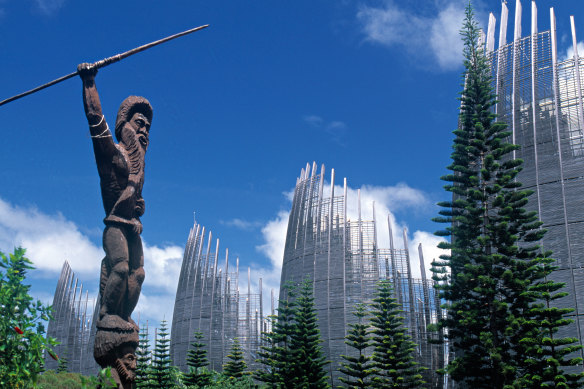
The ribbed steel and timber arrow-shaped towers of the Cultural Centre, inspired by traditional Kanak huts.Credit: Alamy
The staff member assumes I’m an architect, after having asked her whether any celebrations have been held to mark what is the 25th anniversary this year of the construction of this internationally lauded, Renzo Piano-designed building here in New Caledonia.
The truth is, I explain, I’m not an architect, more an architecture dilettante, and I’ve longed to visit this remarkable building since it opened in 1998.
Architect or not, I know enough to realise that this is one of the world’s boldest, yet relatively unknown, buildings right on our doorstep.
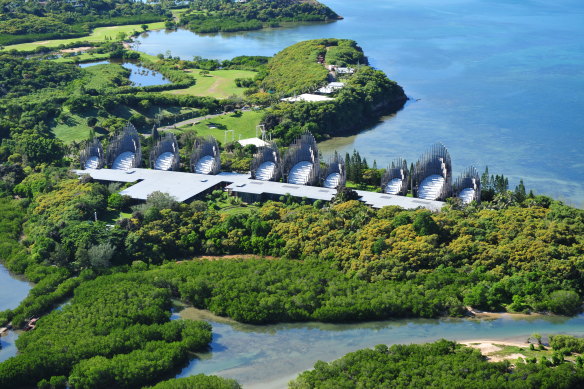
The Cultural Centre from the air.
Oh, and non, there are no plans to mark the anniversary of the centre, a short drive from the heart of Noumea, the 100,000-people strong New Caledonian capital.
But, for me, the silver anniversary of the most fabulous building of this nickel-rich, often troubled French territory, seems a more than appropriate time for my visit, an opportunity to reflect on its significance that extends well beyond its architectural brilliance.
The more I learn about the Cultural Centre before, during and after my visit to Noumea, the more the parallels to it and the Sydney Opera House back home reveal themselves.
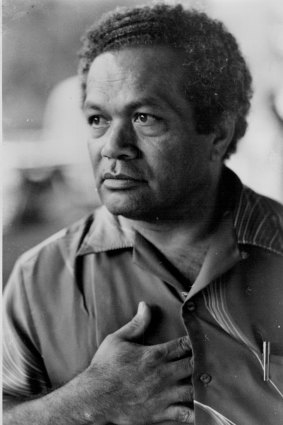
Independence leader, Jean-Marie TjibaouCredit: Anthony Lewis/Fairfax Media
Chief among them are attempts to describe the former building’s main distinctive forms, commonly likening them to everything from sails to shells, just like the Australian construction.
In reality, the centre consists of nearly two dozen ribbed steel and timber arrow-shaped towers, rising between 20 and 30 metres and inspired by traditional Kanak huts.
To my less scholarly eye, at least, as I stroll around the centre’s grounds, they resemble giant, fat-bottomed upright canoes balanced on their bows as they compete for space and attention with equally tall and salubrious pines. Despite its graceful appearance, the building was conceived directly out of conflict between New Caledonia’s French colonial rulers and the indigenous Kanaks, reaching its bloody zenith in a hostage-taking incident on an outer New Caledonian island in the late 1980s.
Members of the Kanak independence movement took more than two dozen gendarmes hostage, along with a number of other officials.
Four gendarmes were killed while a further 19 of the hostage-takers and two members of a French recovery team also died during a rescue mission in what must rank as one of the deadliest single conflicts in the Pacific since World War II.
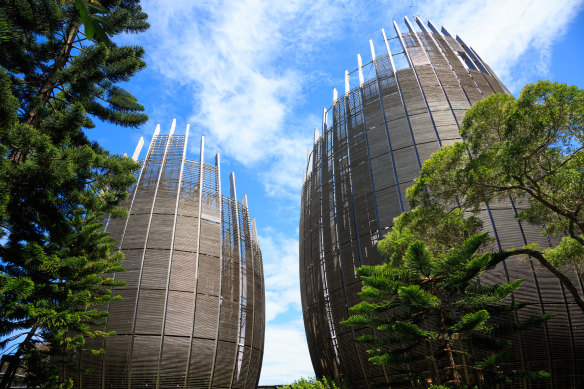
There are no celebrations to mark the 25th anniversary of the building.Credit: iStock
In the ensuing peace talks, the French government agreed to fund and build a cultural centre as a way to recognise New Caledonia’s traditional owners and their unique identity.
Today the Cultural Centre is named in honour of the indigenous Kanak political and independence leader, Jean-Marie Tjibaou, with a whole space and display inside the centre devoted to his life, dramatically ended by an assassin’s bullet in 1989.
Following an official visit by French president Emmanuel Macron to New Caledonia earlier this year, the struggle for Kanak independence continues, with the issue becoming even more complex with France seeking to project and retain its power in the Pacific due the rise of China in the region.
Yet for the casual visitor less interested in such historical background, it’s the architecture of the Cultural Centre and less so its political and cultural import that perhaps understandably tends to dazzle the most.
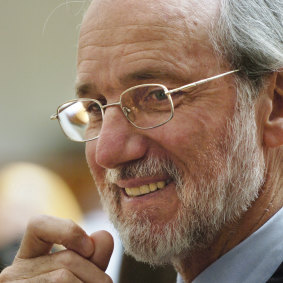
Architect Renzo Piano.Credit: Stan Honda
Aside from the Italian-born Piano’s 41-storey Aurora Place in Sydney – only the same distance to Cairns as it is to Noumea – the majority of the acclaimed architect’s greatest buildings, such as the Centre George Pompidou in Paris and the Shard in London, are located thousands upon thousands of kilometres from Australia and New Caledonia.
In Noumea, then, less than three hours by air from Australia’s eastern seaboard, is the opportunity to experience what Britain’s Royal Academy of Arts once rated as one of the Italian architect’s eight greatest works.
Piano’s main objectives in the design of the Cultural Centre were to combine the Kanaks’ ingenious construction skills and close relationship to nature, while employing the use of sturdier modern and imported materials such as steel, aluminium, glass and stone. The centre’s design was chosen after Piano won an international design competition, a similar scenario to Jorn Utzon and his Opera House design.
The interior of the Cultural Centre, typical of some other monumental and imaginatively sculptured buildings like Frank Gehry’s Guggenheim Bilbao and arguably the Sydney Opera House, is not quite as impressive (though realistically, how could it be?).
That said, it serves a variety of important functions. Beneath the hut towers runs a long, almost processional pathway flanked by exhibition spaces filled with traditional Kanak artefacts, studios for music, dance, painting and sculpture, research libraries and staff offices.
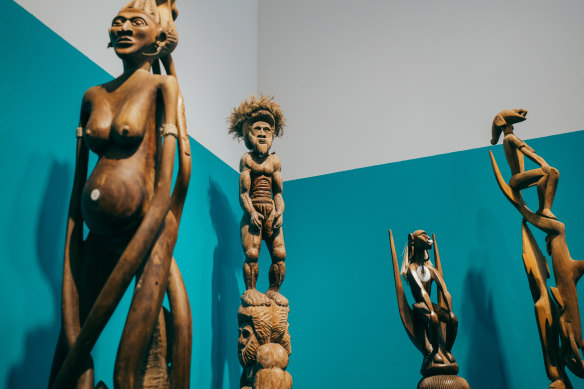
One of the exhibits inside the Cultural Centre.
Not unlike the Opera House, the Cultural Centre occupies a commanding waterside location, extending across eight gorgeously landscaped and mangrove-dotted hectares between Magenta and Tina bays.
Any visit to the complex should therefore include time to wander its tranquil grounds and pathways.
Alas, I can’t follow my own advice. Diverted by some of Noumea’s other myriad attractions, I’ve somehow left my visit a little too late in the day and before too long it’s time to leave.
It’s been a learning curve as steep as those 10 soaring huts combined, all in what’s a closer-than-we-think part of our neighbourhood of which we are, sadly, little aware of.
Five more buildings to visit in Noumea
Noumea Cathedral
A dominant feature of the otherwise diminutive Noumea skyline, the imposing twin-towered Roman Catholic Noumea Cathedral or Cathedrale Saint-Joseph de Noumea, was consecrated in 1890, well before the end of its construction, in 1897.
Colonial houses
Much of Noumea’s 19th-century colonial architectural architecture has succumbed to progress but in the suburb of Faubourg Blanchot there are some surviving examples of the capital’s European past. Five dozen historic homes and buildings form a new walking tour created by Noumea’s municipal council.
La Maison Celieres
Perhaps the loveliest of Noumea’s surviving colonial houses, this stately mansion and gardens is beside the main drag that passes through Faubourg Blanchot. Beautifully restored and surrounded by tall palms, the house now operates as a small museum full of period furniture.
Musee de la Ville
An erstwhile bank that briefly served as Noumea’s city hall, the 19th-century Musee de la Ville de Noumea is today an eclectic colonial-style museum housing exhibits on the impact of nickel mining on New Caledonia and the territory experience of both world wars, including the presence of Australian troops.
Theatre de I’ll
A French prison colony between 1864 and 1924 to which 21,000 prisoners were deported, traces of New Caledonia’s gulag heritage survive right in Noumea including at this former 19th-century jail on the Nouville Peninsula. It now serves as a performing arts venue.
THE DETAILS
Fly
Aircalin, the small though excellent national carrier of New Caledonia, operates daily flights, on a codeshare basis with Qantas, between Sydney and Noumea. See aircalin.com
Visit
The Jean-Marie Tjibaou Cultural Centre is about eight kilometres north-east of the centre of Noumea. Admission $14 an adult with the centre open to visitors every day from 9am, except Mondays. See centretjibaou.nc.
Stay
Guests at the Le Meridien Noumea Resort & Spa receive free admission to the Tjibaou Cultural Centre as part of the resort’s Unlock Art program. Rooms from $295 a night. See marriott.com
The writer travelled as a guest of Aircalin and Tourism New Caledonia. See newcaledonia.travel
Sign up for the Traveller Deals newsletter
Get exclusive travel deals delivered straight to your inbox. Sign up now.